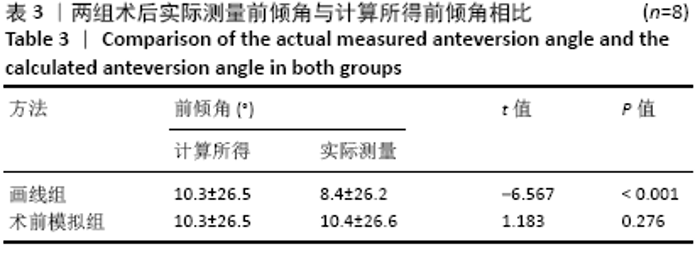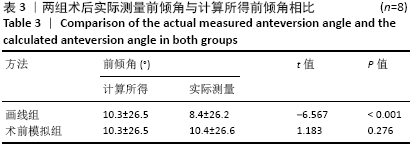[1] BIALIK V, BIALIK GM, BLAZER S, et al. Developmental dysplasia of the hip:a new approach to incidence. Pediatrics. 1999;1:93-99.
[2] 温东栋,梁瑞德.发育性髋关节发育不良治疗进展[J].广西中医药大学学报,2015,18(2):94-97.
[3] 鄂兵,王忠良.发育性髋关节脱位病因学研究进展[J].现代医药卫生,2016,32(16):2526-2528.
[4] ENGESAETER IO, LIE SA, LEHMANN TG, et al. Neonatal hip instability and risk of total hip replacement in young adulthood:follow-up of2,218,596 newburn the medical birth registry of norway in the norwegian arthroplasty register. Acta Orthop. 2008;3:321-326.
[5] BITTERSOHL B, HOSALKAR HS, WENGER DR. Surgical treatment of hip dysplasia in children and adolescents. Orthop Clin North Am. 2012;3: 301-315.
[6] 沙佳,徐会法,严亚波,等.术中使用画线法与量角法测量股骨截骨旋转角度的对比分析研究[J].现代生物医学进展,2017,17(29): 5654-5660.
[7] 安晓龙,付军,蔺广生.三维重建模拟复位固定应用于骨关节创伤微创手术临床研究[J].陕西医学杂志,2019,48(11):1515-1518.
[8] 翁刘其,李明,刘传康,等.股骨颈前倾角的矫正在治疗儿童DDH的价值[J].重庆医学,2013,42(24):2866-2868
[9] LEUNIG M, BECK M, KALHOR M, et al. Fibrocystic changes anterosuperior femoral neck: Prevalence in hips with femoral acetabular impingements. Radiology. 2005;236(1):237-246.
[10] 王树辉,张青,尹同珍,等.骨盆Salter截骨联合股骨截骨治疗儿童发育性髋脱位[J].临床骨科杂志,2019,22(6):675-677.
[11] 徐涛涛,康晓鹏,胡熙.单纯Salter骨盆截骨术与联合股骨近端旋转截骨术在儿童发育性双侧髋关节脱位中的应用[J].中国中医骨伤科杂志,2020,28(5):23-27.
[12] 陈国平,江建中,谢兆林,等.Salter骨盆截骨+股骨转子下短缩旋转截骨术治疗儿童发育性髋脱位[J].临床骨科杂志,2019,22(5): 550-553.
[13] 陶洁,刘卫东,孙雅静.髋臼成形术治疗大龄儿童先天性髋脱位[J].中国矫形外科杂志,2006,3:227-228.
[14] 张义修.骨代谢的生物力学(之一)[J].中国中西医结合外科杂志, 1998,4(4):250.
[15] 张义修.骨代谢的生物力学(之二)[J].中国中西医结合外科杂志, 1998,4(5):318.
[16] 刘复奇,郑志永,薛远亮.发育性髋关节脱位手术截骨中股骨颈前倾角度的选择[J].山东医药,2006,46(20):44-45.
[17] ZHENG G, NOLTE LP. Computer-aided orthopaedic surgery: state-of-the-art and future perspective. Adv Exp Med Biol. 2018;1093:1-20.
[18] 王莹,杨益民,李曙明,等.数字化骨科理念辅助椎弓根置钉在寰枢椎不稳中的临床应用[J].现代生物医学进展,2019,19(16): 3089-3093.
[19] 张涛.Mimics数字化骨科技术重建Pilon骨折及术前模拟复位的初步应用[D].沈阳:中国医科大学,2019.
[20] GEORGE E, LIACOURAS P, RYBICKI FJ, et al. Measuring and establishing the accuracy and reproducibility of 3 d printed medical models. Radiographics. 2017;37(5):1424-1450.
[21] VAN DE BELT TH, NIJMEIJER H, GRIM D, et al. Patient-specific actual size three-dimensional printed models for patient education in glioma treatment: first experiences. World Neurosurg. 2018;117:e99-e105.
[22] FLORSCHUTZ AV, LANGFORD JR, HAIDUKEWYCH GJ, et al. Femoral neck fractures: current management. J Orthop Trauma. 2015;29(3):121-129.
[23] 黄华军,张国栋,欧阳汉斌,等.基于3D打印技术的复杂胫骨平台骨折内固定手术数字化设计[J].南方医科大学学报,2015,35(2): 218-222.
[24] 余光书,许长鹏,林焱斌,等.基于3D打印的虚拟手术设计在复杂胫骨平台骨折内固定中的临床效果观察[J].中国医药科学,2017, 7(21):181-183.
[24] 许玮,张旭鸣,林昊,等.3D打印实体模型在创伤骨科困难手术的应用[J].创伤与急诊电子杂志,2016,4(1):16-20.
[26] 王宏,严亚波,徐超,等.基于三维CT的模拟手术在大龄DDH患儿外科治疗中的应用研究[J].现代生物医学进展,2018,18(3):472-476,523.
|





